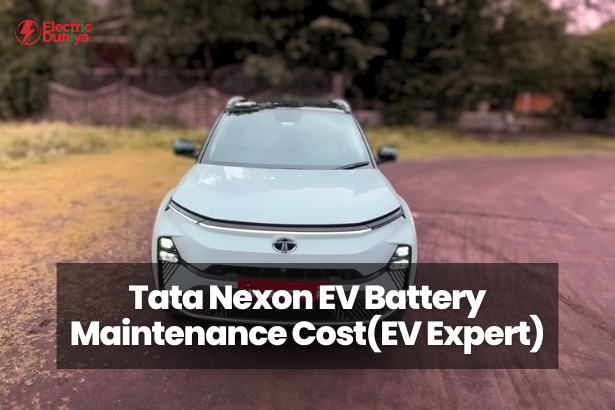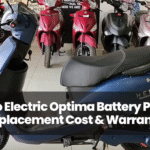When I bought my Tata Nexon EV, I was excited but also a bit worried about one thing, the battery maintenance cost of the Tata Nexon EV.
I wanted to know if keeping the battery in good shape would be expensive or can I afford it.
So, I went to the service centre, asked all my questions, and got the answers I needed.
In this blog, I’ll share what I found out. You’ll learn about the actual costs, what to expect, and whether it’s worth it.
If you’re thinking about getting a Nexon EV or already own one, this will help you understand what you’re getting into.
I will give you honest and relevant information about different aspects of the battery maintenance of the Nexon EV.
About Tata Nexon EV Battery
Before we go into maintenance costs, it is important to understand the basics of EV battery technology.
After doing all this research and talking to some experts, I found out the Tata Nexon EV comes with a 30 kWh and 40.5 kWh pack lithium-ion battery pack for medium and long range.
Lithium-ion batteries are generally used in EVs because of their high energy density, long lifespan, and low self-discharge rate.
The Nexon EV uses Lithium ferrous phosphate (LFP) cells, which are better at handling heat compared to other types like nickel-manganese-cobalt (NMC) cells.
This made me feel more confident about the battery’s durability. Plus, the battery is made in India and has a liquid-cooling system that keeps it from overheating.
It’s also got an IP67 rating, so it’s well-protected against water and dust, and the design helps it get rid of heat efficiently.
One thing that put my mind at ease is the 8-year or 160,000 km warranty on the battery. If something goes wrong during that time, Tata will replace it for free.
But I did find out that after the warranty ends, replacing the battery could cost around Rs. 7 to 8 lakhs, which is almost 50% of the vehicle cost.
Tata Nexon EV Battery Maintenance Cost
When I went to the service centre expert about maintaining the battery of Tata Nexon EV, he broke down the costs for me, and it’s pretty reasonable.
The yearly service will set you back about ₹2,301, which covers the basic stuff like spares and consumables.
There’s also a mid-year service that’s even cheaper, around ₹1,250 because it doesn’t need any extra parts.
The expert told me that every six months, you’ll need to change the axle oil, which increases the cost a little more.
He also mentioned that you’ll need to change the transaxle oil every 4 years or after 30,000 km, so it’s not something you’ll deal with often.
The coolant needs changing every 3 years or 45,000 km, and that costs about ₹989.
After doing all the calculations and considering different services of battery, the yearly battery maintenance costs a maximum of ₹4000.
If the battery requires a complete replacement, the Nexon EV battery replacement cost is something you may want to explore beforehand to budget appropriately.
The expert said that’s one of the perks of having an EV—fewer moving parts mean fewer things can break, so you end up spending less on maintenance.
Factors that Affect Battery Life
The expert told me that if I want to increase the lifespan of my Tata Nexon EV battery, it is important to understand the factors that affect its long life span.
Avoiding deep discharges by letting the battery completely drain can help prolong its lifespan.
Irregular charging patterns like frequent rapid charging, can impact battery health.
Extreme temperatures, humidity, and exposure to sunlight can impact battery performance and lifespan.
Aggressive driving, like rapid acceleration and braking, can reduce battery life.
To ensure optimal battery performance and extend its lifespan, follow these best practices:
👉 Charge your Nexon EV regularly focusing on 20-80% charge level.
👉 Park your vehicle in shaded areas or use a sunshade to reduce exposure to direct sunlight.
👉 Regularly update the software of the vehicle to ensure optimal battery performance.
Keep an eye on your battery’s health through onboard diagnostics or by consulting with a Tata Motors authorised service centre.
Is Battery Maintenance Cost Worthy?
Despite the initial higher upfront cost, the Tata Nexon EV offers numerous benefits that make it an attractive option.
If you ask me about the benefits of EVs over petrol cars, one big advantage is that EVs are much cheaper to run.
Electricity costs around ₹1-₹2 per kilometre, while petrol or diesel cars can cost ₹10-₹15 per kilometre.
The Nexon EV produces zero tailpipe emissions, contributing to a cleaner environment and reducing your carbon footprint.
EVs provide a smoother, quieter driving experience, making for a more comfortable ride.
The Indian government offers incentives, such as tax benefits and subsidies, to encourage EV adoption.
Final Thoughts
While the battery maintenance cost of the Tata Nexon EV may seem high, it is essential to consider the bigger picture. This is what the expert told me.
With lower operating costs, environmental benefits, and government incentives, the Nexon EV offers a compelling case for those looking to switch to electric mobility.
By understanding the costs associated with battery maintenance and following best practices, you can enjoy the benefits of EV ownership by minimising expenses.
Tata Nexon EV battery is designed to last, and with proper care, it will provide years of reliable service.







